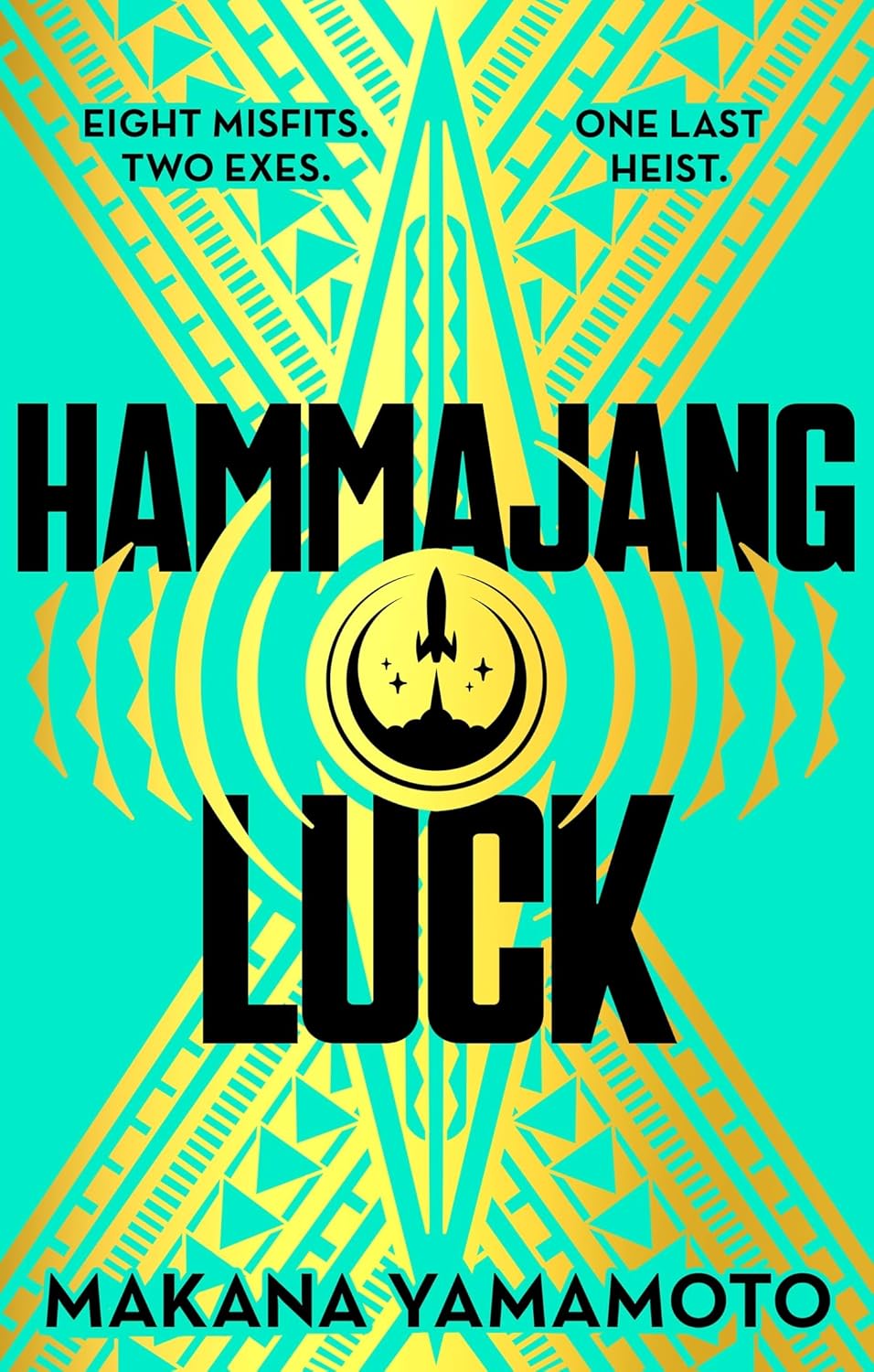Hammajang Luck by Makana Yamamoto: Review by Alexandra Pierce
 Hammajang Luck, Makana Yamamoto (Gollancz 978-1-39961-679-9, £20.00, 336pp, hc) December 2024. Cover by Jordan Wolfe. (Harper Voyager 978-0-06343-082-2, $19.99, 368pp, tp). January 2025. Cover by Janelle Barone.
Hammajang Luck, Makana Yamamoto (Gollancz 978-1-39961-679-9, £20.00, 336pp, hc) December 2024. Cover by Jordan Wolfe. (Harper Voyager 978-0-06343-082-2, $19.99, 368pp, tp). January 2025. Cover by Janelle Barone.
I love a heist story. Getting the conspirators together, finding out the plan, overcoming obstacles, finding out the real plan, watching it all unravel and then neatly come back together… I know the beats of the story, and that’s part of what makes it fun. Which particular tropes will this particular story follow? Will there be a double-cross? Will there be a surprise plan-within-a-plan? Just how awful is the target of the heist, and how long will it take for the team to work as a well-oiled machine? Makana Yamamoto’s debut Hammajang Luck – a queer cyberpunk heist set on a space station and steeped in Hawai’ian culture – is a splendid addition to the genre.
Edie Morikawa finds themself unexpectedly released from jail: They’ve served eight years but they’re not up for parole for another six months. Meeting them as they step out of prison is Angel – the woman who betrayed them after their last job together, leading to Edie’s prison sentence. It turns out Angel has secured their release, with the expectation that Edie will do one last job (and aren’t they famous last words?). After the usual stubborn refusal, and the discovery of being blacklisted from any employment opportunities, Edie succumbs to the inevitable. The promise of 125 billion credits helps.
One of the things that really helps sell a heist story is the villainy of the target, and Yamamoto has gone all out with Joyce Atlas. A multitrillionaire, one of the richest men in the galaxy, responsible for most of the communication tech used across society and now moving into human-machine interfaces (oh no, not reflecting on modern issues at all). Apparently a philanthropist, his businesses are responsible for jacking up the cost of goods as well as rents, thus driving lower-income families out of their homes. His companies are involved in surveillance tech, the information from which is then sold to governments and advertisers. And next on the agenda is developing technology that would allow someone’s memories to be altered. Joyce Atlas is entirely believable – a logical extension of capitalist entrepreneurship that we see in the 21st century – and also a target that I felt little compassion for; I had no compunctions in cheering on Edie, Angel, and their crew. Perhaps the most fascinating aspect of the heist is the actual target itself: Steal the blueprints and physical prototypes for Atlas’s technology, and then ransom them back to him. Obviously not victimless, but a very neat way around the issue of harm.
Getting the team together takes about a third of the book, which introduces the characters smoothly. Edie’s job is to be the runner: They know the pipes and tunnels of Kepler, and can therefore figure out physical access to areas like, for instance, the location of the physical safe Atlas uses to store important items. The rest of the team includes the tech whiz, the safecracker, the distraction, the muscle, and finally the organiser: Angel, who is actually head of Atlas’s security. This opening introduces the setting, too: the heist is taking place on Kepler Space Station, and there’s a degree of claustrophobia as Edie makes their way around, because the station is organised vertically and horizontally. Ward 7 is the highest and poshest: There’s actual light up there, from the simulated sky, which never filters down to Ward 1 thanks to the towers, skybridges, and traffic that get in the way. Kepler is a deeply class-divided society, physically and socially; Yamamoto’s focus on the lower echelons – the mechanics and tiny business owners – is realistic and full of love. These aren’t people desperate to improve their lot by any means necessary; they are people who love their neighbourhood and their neighbours – although lifts that work and better access to healthcare would certainly be welcomed.
With queer and trans characters, an is-this-a-romance, excellent team banter, and an exasperated sibling for Edie, all on top of a daring and audacious heist, there is an enormous amount to love in Hammajang Luck. Books that come out at the end or start of the year can get lost in the chaos, and that goes double for debuts; I would hate for this novel to not get the attention it deserves just because of the publishing timetable. Apparently Yamamoto has sold two more novels in this same universe, and I’m already waiting impatiently for them. I look forward to seeing where they go next.
Interested in this title? Your purchase through the links below brings us a small amount of affiliate income and helps us keep doing all the reviews you love to read!
Alexandra Pierce is the editor and publisher of the nonfiction Speculative Insight: A Journal of Space, Magic, and Footnotes. She is an Australian and a feminist, and was a host of the Hugo Award-winning podcast Galactic Suburbia. Alex has edited two award-winning non-fiction anthologies, Letters to Tiptree and Luminescent Threads: Connections to Octavia E. Butler.
This review and more like it in the January 2025 issue of Locus.
 While you are here, please take a moment to support Locus with a one-time or recurring donation. We rely on reader donations to keep the magazine and site going, and would like to keep the site paywall free, but WE NEED YOUR FINANCIAL SUPPORT to continue quality coverage of the science fiction and fantasy field.
While you are here, please take a moment to support Locus with a one-time or recurring donation. We rely on reader donations to keep the magazine and site going, and would like to keep the site paywall free, but WE NEED YOUR FINANCIAL SUPPORT to continue quality coverage of the science fiction and fantasy field.
©Locus Magazine. Copyrighted material may not be republished without permission of LSFF.






